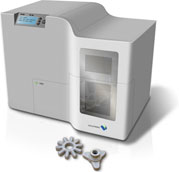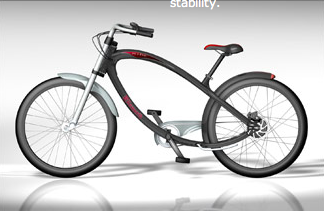 The race is on to build low cost rapid prototyping systems! 3D Systems is soon to unveil their V-Flash for $10k, and now California startup Desktop Factory is working on an even less expensive prototyping system, to be priced around $5-7k. The V-Flash has the edge on build size, sporting a 7x9x8 build area versus the 5x5x5 inch build area from Desktop Factory. It’ll be interesting to see a head to head comparison of these two systems once they both hit the market.
The race is on to build low cost rapid prototyping systems! 3D Systems is soon to unveil their V-Flash for $10k, and now California startup Desktop Factory is working on an even less expensive prototyping system, to be priced around $5-7k. The V-Flash has the edge on build size, sporting a 7x9x8 build area versus the 5x5x5 inch build area from Desktop Factory. It’ll be interesting to see a head to head comparison of these two systems once they both hit the market.
Author Archives: Matt
NuVinci Bicycle CVT
Check out this video overview of a compact CVT (Continuously Variable Transmission) from Fallbrook Technologies, based on a concept proposed by Leonardo DaVinci. While this seems brilliant and well suited to bicycle or other low power applications, I am skeptical about the manufacturer’s claims of its potential for use in cars – I question whether it could really handle higher power levels. It’s still a great technology with lots of potential applications though.
You can read more about CVTs here.
(via Coolhunting)
The transmission will be appearing in this cool looking bike from Ellsworth.
Web-based software tools to manage a business
Small startups will find an abundance of internet-based software that can help them run their business – everything from to-do lists, file sharing, contact management, scheduling, payroll, etc. So, where do you start? Well, this article from the Chicago Tribune has a great summary, which I’ll include in the extended version of this post.
Continue reading
Apple two-shot molding patent application
Apple Computer has filed a patent application (not yet granted!) covering two-shot injection molding. While initial press concerning this patent application refers to it as a patent that covers a two layer molding process common to the iPod and Microsoft’s Zune (see link in Design News), my own reading of the patent application is somewhat different. While it may indeed be broad enough to cover that type of product design, I think it’s geared more towards describing a way to mold very small parts that simply cannot be molded in a single shot. For example, a small part with undercuts may not have room in the tool for the lifters required. This patent application describes a process where the part would be molded in more than one step – some of the features, like walls, would not be molded initially so that the smaller, more challenging features may be molded more easily. A second, or even third, shot would then be used to finish the overall part. I think it’s worth noting that this is just a patent application; an actual patent has not yet been issued as far as I can tell. Still, it’s important to keep this patent in mind when designing plastic parts, to avoid future patent related problems for your employer stemming from what you thought was a very creative way of solving a molding problem. It’s patent application #20070048470.